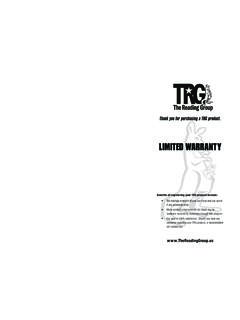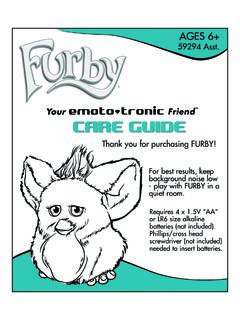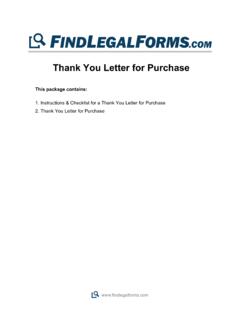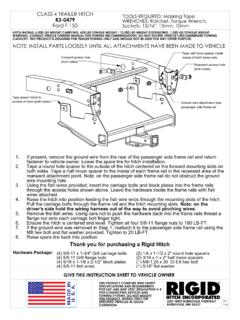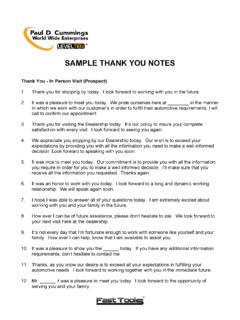Transcription of Thank you for purchasing a Liberty FT wheelchair!
1 1 Thank you for purchasing a Liberty FT wheelchair! Please do not use this wheelchair without first reading this entire manual. BEFORE riding, you should be trained in the safe use of this chair by an Assistive Technology Practitioner (ATP) or clinical you have any questions or concerns about any aspect of this wheelchair, this manual, or the service provided by us or your retail supplier, please do not hesitate to contact us by telephone at:715-254-0991In writing at:Ki Mobility5201 Woodward DriveStevens Point, WI email via our Authorized EU Representative: James Leckey Design19C Ballinderry RoadLisburnBT28 2 SAPhone: 0800 318265 (UK) or 1800 626020 (ROI) INTRODUCTION2I. INTRODUCTIONII. TABLE OF CONTENTSIII. NOTICE - READ BEFORE Safety and 3IV. WARNINGSA. Signal 3B. General 4C. Positioning Belts or 5D.
2 Riding Your 5E. Power 6F. Ascending 6G. Descending 7H. Transfers .. 7I. Your Wheelchair and the 7J. Modifying your 8K. Wheelchair 8L. Aftermarket Seating .. 9V. SET UP & USE OF YOUR WHEELCHAIRA. Your Liberty FT & It s 10B. Transit 11C. Height Adjustable 14D. Tubular Flip Up 15E. Angle Adjustable Locking Flip Up Extendable 16F. Swing Away 17G. Swing Away Hangers with 4-Way 17H. Extension 18I. Elevated Leg 19J. Pro Elevated Leg 20K. Multi-Angle 21L. 22M. Adjusting/Installing 23N. Folding and Unfolding Chair .. 24O. Tilt 26P. Rear 27Q. Wheel 28R. 29S. Oxygen Tank Holder .. 29VI. MAINTENANCEA. Inspecting Your 30B. Routine 31C. 32D. 32 VII. TABLE OF CONTENTSLa Versi n en Espa ol comienza en la p gina 343 III. NOTICE - READ BEFORE USEA.
3 Your Safety and StabilityKi Mobility manufactures many different wheelchairs that might meet your needs. You should consult an Assistive Technology Professional when selecting which model would best meet your particular requirements and how the wheelchair should be set up and adjusted. Final selection of the type of wheelchair, options and adjustments rests solely with you and your medical professional. The options you choose and the set-up and adjustment of the wheelchair have a direct impact on its stability. Factors to consider that affect your safety and stability are:a. Your personal abilities and capabilities including strength, balance and The types of hazards and obstacles you might encounter during your The specific dimensions, options and set up. In particular, the seat height, seat depth, seat angle, back angle, size and position of the rear wheels and size and position of the front WARNINGSA.
4 Signal WordsWithin this manual you will find what are referred to as Signal words. These words are used to identify and convey the severity of varying hazards. Before using this chair you, and each person who may assist you, should read this entire manual. Please note the Signal word and consider any warnings, cautions or dangers. Make sure to follow all instructions and use your chair safely. The Signal word refers to a hazard or unsafe practice that may cause severe injury or death to you or to other persons. The Warnings are in two main categories, as follows:WARNING Warning indicates a potentially hazardous situation which, if not avoided, could result in serious injury or Caution indicates a potentially hazardous situation which, if not avoided, could result in injury or damage to your signal words will be placed throughout the manual, where appropriate to highlight the hazardous situation.
5 Refer to the following list for hazardous situations that will apply to the general use of this : Failure to comply with all of the instructions in this manual or using the wheelchair in a manner not stated in this manual could result in serious injury or WARNINGSB. General WarningsWARNING: Do not exceed weight limit of chair:Limits refer to combined weight in pounds of user and all items carried. Exceeding weight limit may damage your chair or may increase your risk of falling or tipping over. A tip-over or fall could result in serious injury or death. Do not use chair for weight training. The movement of the additional weight alters the chair s center of gravity increasing your risk of tipping over. A tip-over could result in damage to your chair or in serious injury or death. Keep tires inflated to correct tire pressure.
6 Using a chair without properly inflated tires may affect its stability, increasing your risk of tipping over. A tip-over could result in damage to your chair or in serious injury or death to you or others. Correct tire pressure is indicated on the side wall of the tire. Your wheelchair provider can determine if your tires are inflatable if you are unsure. Underinflated tires may cause your wheel locks to not function properly. Failure of the wheel locks to hold your chair may result in a loss of control or fall. This can result in serious injury or death. Avoid ramps or slopes inclined more than 9 degrees. Steep slopes increase your risk of falling or tipping over. A tip-over or fall could result in damage to your chair or in serious injury or death to you or others. Do not use chair on ramps or slopes tilted more than 9 degrees (about 2 inches rise/drop per linear-foot): neither up/down nor across.
7 Avoid inclined surfaces slick or coated with ice, oil or water. Slippery inclines could result in falling or tipping over. A tip-over or fall could result in damage to your chair or in serious injury or death. Avoid leaning over the side or back of your wheelchair to extend your reach. Leaning over chair could change its center of gravity and cause an unstable situation resulting in a fall or tip-over. A tip-over or fall could result in damage to your chair or in serious injury or death. Do not lift wheelchair by its removable parts while occupied. Lifting a wheelchair by removable parts - armrests or footrests - while occupied could cause user to fall or lose control. A fall or loss of control could result in damage to your chair or in serious injury or : Avoid overtightening bolts and hardware that attach components to the frame.
8 Over-tightening could cause damage to the chair; affecting its durability and performance. NOTE: If you are unsure how to properly tighten bolts or hardware, consult your authorized FT250 lbs (113 kg)5IV. WARNINGSC. Positioning Belts or HarnessesWARNING: Never leave a user who cannot maintain their own seated posture unattended when using positioning belts or harnesses. The user may slide down and become entangled in the belt or harness which may result in severe injury or belts are designed to assist with proper positioning within the wheelchair. They are not designed as seat belts. Use positioning belts ONLY to help support the user s posture. Misuse of positioning belts may result in severe injury or death. Ensure the user does not slide underneath the positioning belt in the wheelchair seat. If this occurs, the user s breathing may be hampered causing death or serious injury.
9 The positioning belt should have a snug fit; tight enough to hold their position, but not so tight as to restrict breathing. You should be able to slide your hand between the positioning belt and the user. NEVER Use Positioning Belts: a. As a restraint. A restraint requires a doctor s order. b. On a user who is unconscious. c. As an occupant restraint in a motor vehicle. A positioning belt is not designed to replace a seat belt that is attached to the frame of a vehicle, which would be required of an effective seat belt. During a sudden stop, with the force of the stop, the user would be thrown forward. Wheelchair seat belts will not prevent this, and further injury may result from the belts or straps. See Transit Use (V. Set Up & Use of Your Wheelchair - Section B). D. Riding Your WheelchairYour chair is designed for use on solid, flat surfaces such as concrete, asphalt and flooring.
10 Use caution if you push your wheelchair on a wet or slick : Avoid pushing or using your chair in sand, loose soil or over rough terrain. Use over such surfaces could cause a loss of stability and result in a fall or loss of control. A fall or loss of control could result in damage to your chair or in serious injury or death. Avoid using your wheelchair on a public road. Use of a wheelchair on a public road could result in serious injury or death. Wheelchairs are not legal for use on public roads in most states. If you find you must use a chair on a public road, be alert to the danger of motor vehicles. Avoid obstacles and road hazards. Obstacles and hazards - potholes, broken pavement - could cause a fall, tip-over or loss of control. A fall, tip-over, or loss of control could result in damage to your chair or in serious injury or death.





